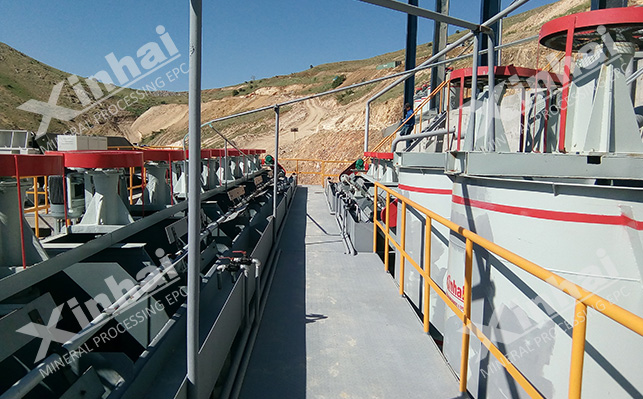Lead oxide has significant value in the field of mineral resources. The main lead containing minerals in lead oxide include galena, lead alum, etc. These minerals appear in various forms, often in the form of blocks, granules, or soil. And the coexisting gangue minerals include quartz, feldspar, mica, etc. In the actual production process, most beneficiation plants use sulfide flotation method to separate oxidized lead ore, which has important scientific principles behind it.
Lead oxide mineral is a relatively soluble mineral, and during the beneficiation process, a large amount of lead ions are released from the mineral lattice into the slurry solution. This phenomenon can cause instability on the mineral surface, which in turn affects flotation efficiency. To solve this problem, it is necessary to first sulfide the lead oxide mineral. The sulfurization process usually uses sodium sulfide, and when sodium sulfide interacts with lead oxide minerals, the main reactant is HS -. HS - in the slurry solution will adsorb on the mineral surface, and then undergo ion exchange reaction with lead atoms on the mineral surface, thereby generating hydrophobic lead sulfide products. This process activates the flotation of lead oxide minerals, enabling them to be better captured by flotation agents.

Sulfide xanthate flotation method is a commonly used flotation method for oxidized lead ore. In this process, a sulfurizing agent, usually sodium sulfide, is first added to the oxidized lead ore slurry. Sodium sulfide reacts with mineral surfaces to form sulfide films of lead. This sulfurized film changes the surface properties of the mineral, transforming it from hydrophilic to hydrophobic. Next, add yellow medicine to the slurry. Huangyao interacts with the surface of sulfided minerals, further enhancing their hydrophobicity. Finally, the minerals are separated through flotation.
Case: In a lead oxide mine, the sulfide yellow medicine flotation method has achieved good results. Technicians precisely control the amount and addition time of sodium sulfide based on the properties of the ore to ensure that the sulfurization reaction proceeds fully. At the same time, choose the appropriate type and dosage of yellow medicine to effectively float out the minerals. After a series of process steps, the mine has successfully increased the recovery rate of lead oxide, bringing considerable economic benefits to the enterprise.
Direct flotation with anionic collectors is another method for treating oxidized lead ore. This method directly uses anionic collectors, such as fatty acids, sulfonic acids, phosphonic acids, etc., to chemically or physically adsorb metal ions on the surface of lead oxide minerals. Through this adsorption process, the mineral surface becomes hydrophobic, thereby achieving flotation.
Different types of anionic collectors have different characteristics and applicable ranges. Fatty acid collectors typically have the advantages of low cost and wide availability, but their selectivity towards minerals may be relatively low. Sulfonic acid and phosphonic acid collectors may have higher selectivity and collection ability, but their prices may be relatively high. In practical applications, it is necessary to select suitable anionic collectors based on the specific properties and production requirements of the ore.
Case: A certain beneficiation plant selected a sulfonic acid based anionic collector after experimental comparison when processing a specific type of oxidized lead ore. By optimizing the dosage of collectors and flotation process parameters, the flotation recovery rate of lead oxide has been successfully improved, while reducing production costs.
The chelating agent neutral oil flotation method is also an effective flotation method for oxidized lead ore. This method uses chelating agents such as 8-hydroxyquinoline, benzotriazole, etc. to form stable chelates with metal ions on the surface of lead oxide minerals. Then, neutral oils such as kerosene, diesel, etc. are added to make the minerals hydrophobic, thereby achieving flotation.
Chelating agents can form strong and stable chemical bonds with metal ions on mineral surfaces, thereby enhancing the hydrophobicity of minerals. Neutral oil plays an auxiliary role, further enhancing the floatability of minerals. This method may have unique advantages in dealing with some difficult to select oxidized lead ores.
Case: In a difficult to select lead oxide mine, technicians conducted experiments using chelating agent neutral oil flotation method. By selecting appropriate chelating agents and neutral oil types, as well as optimizing process parameters, the recovery rate of lead oxide has been successfully improved. This method provides new ideas and approaches for dealing with difficult to select oxidized lead ore.
In short, the lead oxide flotation process is a complex and critical process. Different flotation methods have their own characteristics and scope of application. In practical production, it is necessary to comprehensively consider factors such as the specific properties, production requirements, and economic benefits of lead oxide ore. Choosing an appropriate flotation method and optimizing process parameters can effectively improve the recovery rate of lead oxide and achieve efficient utilization of resources. Meanwhile, with the continuous advancement of technology, it is believed that there will be more innovative lead oxide flotation processes and methods in the future, bringing new opportunities and challenges to the development of lead oxide mining.